Menus
- Four naked bikes in the test
- Honda CB 650 F has the highest performance
- CB 650 F costs 7,995 euros
- Kawasaki ER-6n is already scratching its hooves
- The Kawa is a chic fun vehicle for 6395 euros
- The design of the new Suzuki SV 650 is based on earlier models
- And the Yamaha MT-07?
- Technical data and measured values
- MOTORCYCLE scoring
- MOTORCYCLE test result
- Price comparison of the four mid-range naked bikes
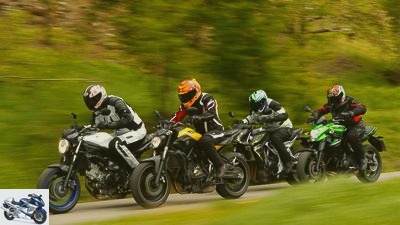
www.bilski-fotografie.de
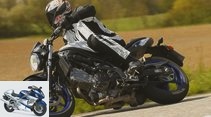
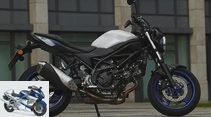
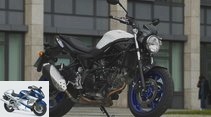
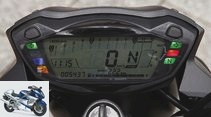
34 photos
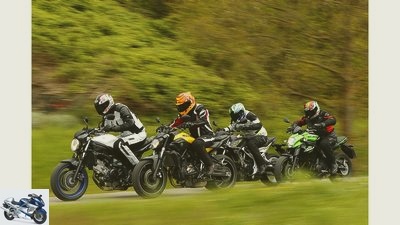
www.bilski-fotografie.de
1/34
They are the hottest contenders among the mid-range naked bikes.
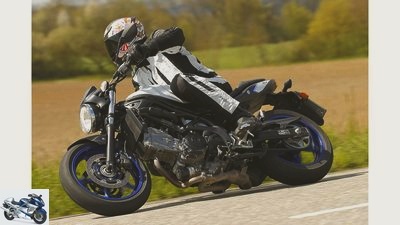
www.bilski-fotografie.de
2/34
The Suzuki SV 650 is not the handiest, but lies well on the road. Only the feedback should be better.
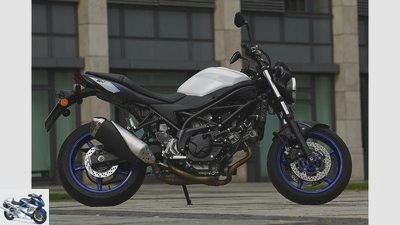
www.bilski-fotografie.de
3/34
White basic tone, blue color elements as an extra.
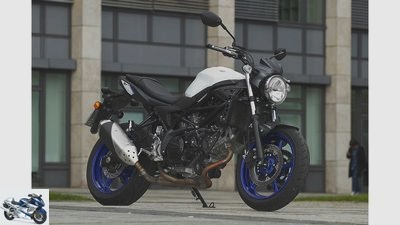
www.bilski-fotografie.de
4/34
The Suzuki SV 650 loves things factual, sober, is not a blender, but convinces with its function.
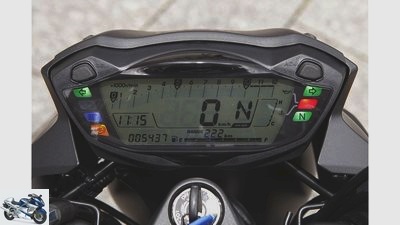
www.bilski-fotografie.de
5/34
The cockpit provides all the important information at a glance. Nice: The remaining range drops only slowly thanks to the low consumption.
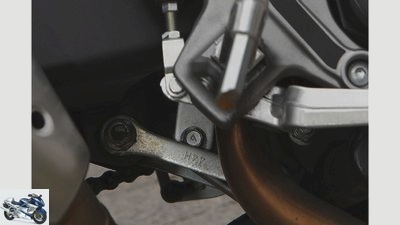
www.bilski-fotografie.de
6/34
Exception: Only the Suzuki SV 650 and the Yamaha MT-07 have a deflection on the rear shock absorber.
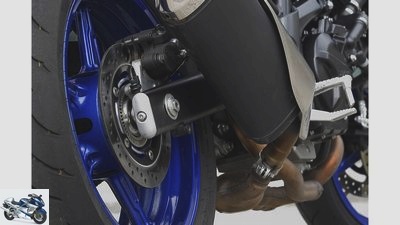
www.bilski-fotografie.de
7/34
Classic muddle of manifolds and real exhaust: only the Suzuki SV 650 has that, while all the others have massive front silencers.
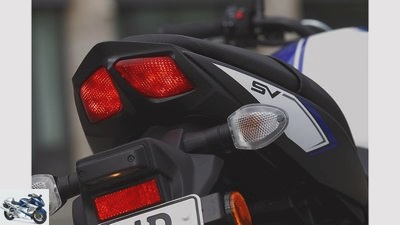
www.bilski-fotografie.de
8/34
Two single lights shine to the rear of the SV and fit perfectly into the slim rear of the Suzuki SV 650.
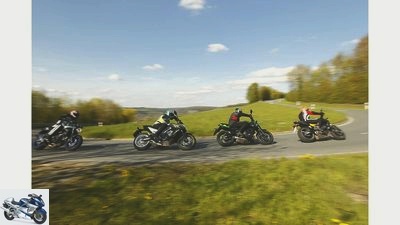
www.bilski-fotografie.de
9/34
The Yamaha MT-07 always ahead.
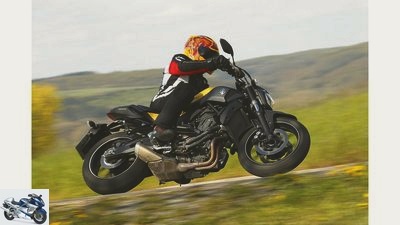
www.bilski-fotografie.de
10/34
Wipe it away: no one flies around corners as easily as the Yamaha MT-07, despite its 180 mm rear tire.

www.bilski-fotografie.de
11/34
The Yamaha MT-07 is the lightweight of the test field.
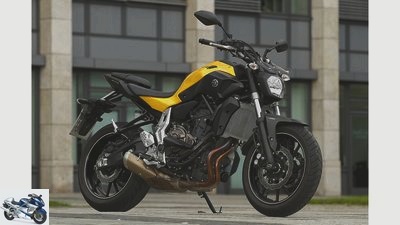
www.bilski-fotografie.de
12/34
That there is not much to it is shown by its shape, short and stocky.
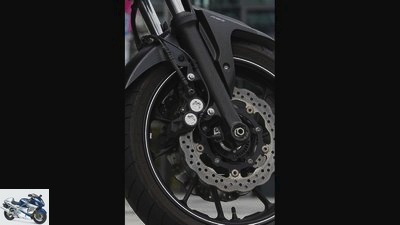
www.bilski-fotografie.de
13/34
Powerful bite: The four-piston fixed calipers of the Yamaha MT-07 allow crisp delays with good dosage.
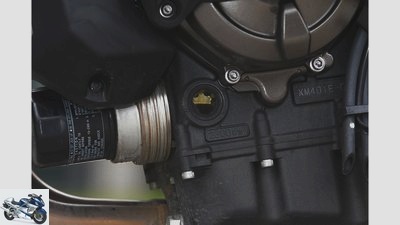
www.bilski-fotografie.de
14/34
Like the Suzuki SV 650 and the Kawasaki ER-6n, the Yamaha MT-07 has an oil sight glass. One glance is enough to check the important lubricant.
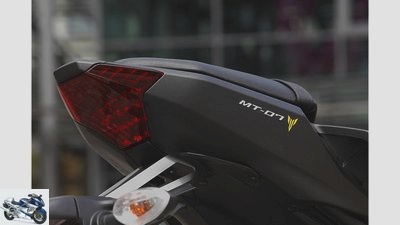
www.bilski-fotografie.de
15/34
The rear light of the Yamaha MT-07 is V-shaped and fits seamlessly into the rear fairing.
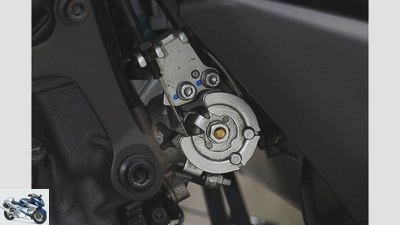
www.bilski-fotografie.de
16/34
Not a real ride-by-wire: As with the Yamaha MT-07, all models have an opener and a closer to the injection system.
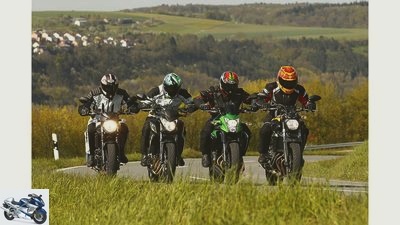
www.bilski-fotografie.de
17/34
Kawasaki ER-6n, Suzuki SV 650, Yamaha MT-07 and Honda CB 650 F.
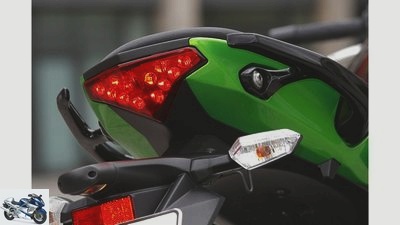
www.bilski-fotografie.de
18/34
The triangle as a stylistic device, the rear light is nicely integrated into the rear of the Kawasaki ER-6n. Kawa can design.
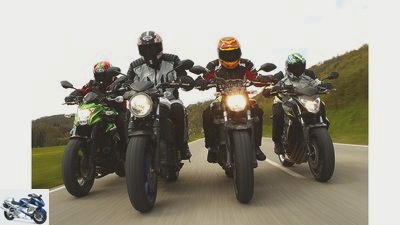
www.bilski-fotografie.de
19/34
Kawasaki ER-6n, Suzuki SV 650, Yamaha MT-07 and Honda CB 650 F.
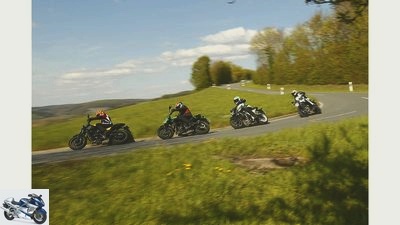
www.bilski-fotografie.de
20/34
The Honda CB 650 F, Kawasaki ER-6n and Yamaha MT-07 are among the top sellers of their respective brands.
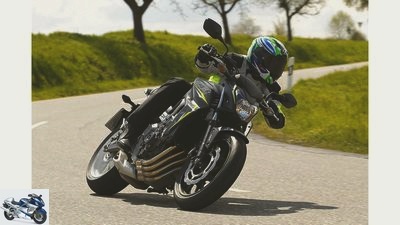
www.bilski-fotografie.de
21/34
Regardless of the nature of the asphalt, the Honda CB 650 F rolls over it stably and with a lot of feedback. That makes you relaxed and quick.
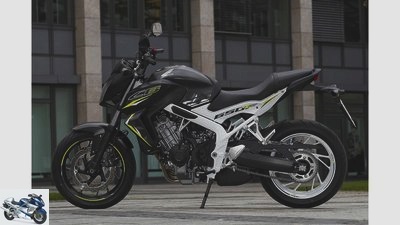
www.bilski-fotografie.de
22/34
The Honda demonstrates what cleverly set color accents can make. Eye-catching white frame and rear rim.
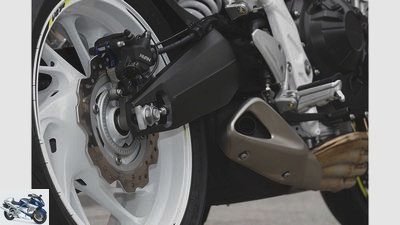
www.bilski-fotografie.de
23/34
Fine swing arm, wave brake disc and high-quality chain tensioner on the Honda CB 650 F, which is made in Thailand.
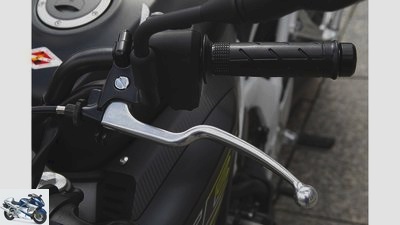
www.bilski-fotografie.de
24/34
The clutch lever is difficult to reach, even for giant hands. This makes starting off unnecessarily difficult.

www.bilski-fotografie.de
25/34
Take a bearing with a stick, please. The Honda CB 650 F is the only one of the test quartet to have no oil sight glass.
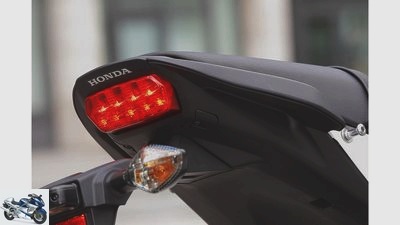
www.bilski-fotografie.de
26/34
The rear light on the Honda CB 650 F looks a little bulky, massive. It’s a functional rather than a design part.
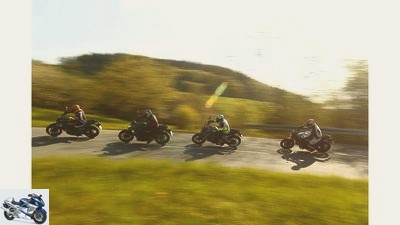
www.bilski-fotografie.de
27/34
The Yamaha MT-07 gives the acceleration primer, is consistently ahead of the others.
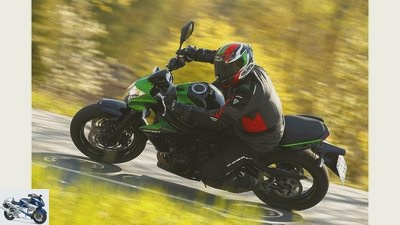
www.bilski-fotografie.de
28/34
On the Kawasaki ER-6n only the belief in the tire grip helps for steep slopes. Suspension feedback: expandable.
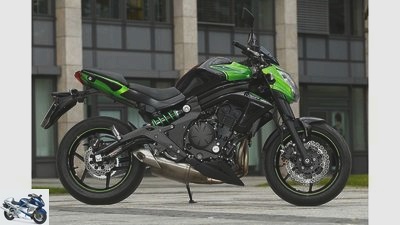
www.bilski-fotografie.de
29/34
Everything in swing: The design of the Kawasaki ER-6n focuses on flowing lines, is modern and attractive.
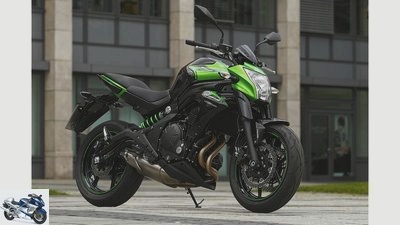
www.bilski-fotografie.de
30/34
As always in life, it is not only the outer shell that matters, but also the inner core.
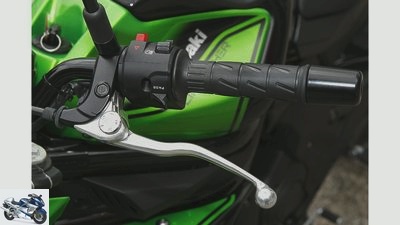
www.bilski-fotografie.de
31/34
Exemplary: Only on the Kawasaki ER-6n is the clutch lever adjustable in reach.
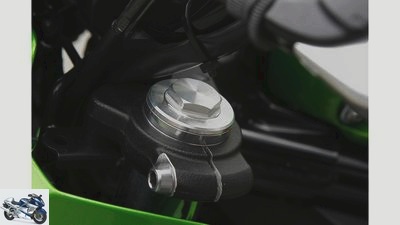
www.bilski-fotografie.de
32/34
This is what the upper fork plug looks like on all test bikes. There are no adjustment options for damping or preload.
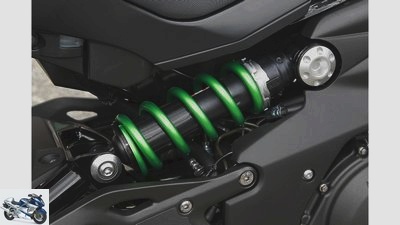
www.bilski-fotografie.de
33/34
Mounted directly and without deflection between the frame and swing arm, the shock absorber works.
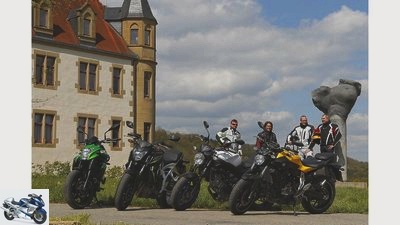
www.bilski-fotografie.de
34/34
Happy faces: These motorcycles are just great fun, which gets even better when you look at the price tag.
Suzuki SV 650, Honda CB 650 F, Kawasaki ER-6n and Yamaha MT-07
Four naked bikes in the test
The hottest candidates among the bare mid-range bikes from the four Japanese manufacturers with more than 70 hp are the Honda CB 650 F, Kawasaki ER-6n and Yamaha MT-07. The new Suzuki SV 650 wants to have an important say in this class again.
Middle class is not a nice term. Reasonable motorcycles, bread-and-butter bikes – all of that sounds conservative, gives the feeling that it wasn’t enough for more. But this perspective is not entirely correct, after all, the Honda CB 650 F, Kawasaki ER-6n and Yamaha MT-07 to the top sellers of the respective brand. At Kawasaki and Yamaha, they are the undisputed number one in the registration statistics for the past two years. They are currently right at the front again. So you have a lot of friends among the two-wheeled youngsters. And there are very objective reasons for this. Without anticipating the test result: All of them are on the one level in terms of price / performance rating of the MOTORRAD 1000 point rating. Some people at school would have dreamed of this. At Suzuki they want to go back there, send the current Suzuki SV 650 to the start for comparison. It inherits the Gladius 650. Does the new one have what it takes to get back to the fore among the bare music enthusiasts?
Buy complete article
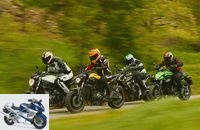
Suzuki SV 650, Honda CB 650 F, Kawasaki ER-6n and Yamaha MT-07
Four naked bikes in the test
The CB 650 F is the only one in the comparison with an in-line four-cylinder. From exactly 649 cm³ the develops 87 horse power at 11,000 / min. The highest performance of the test foursome. However, he has to be content with only 63 Nm as the maximum torque value. The others shovel a few Newton meters more onto the crankshaft. The performance data already give an idea of the engine characteristics. The CB 650 F likes speeds, needs speeds. Seemingly as a confirmation, your engine turns a little higher without having to do anything with the throttle, the pistons are automatically tuned to what you expect.
Honda CB 650 F has the highest performance
This continues seamlessly when starting up. The widely protruding clutch handle, which is difficult to grasp even with XXL hands and cannot be adjusted, the tight dosing point of the clutch and the poor starting torque demand a lot of speed. Often the clock on the display shows a good 3000 to 4000 revolutions when driving off. If the CB 650 F is to move forward quickly, the four-cylinder has to cheer. No problem, with its broad speed range, which reaches almost 12,000 rpm. It’s screaming through the Winkelwerk. But if you equate onomatopoeia with speed, you will be disappointed to some extent. The Honda CB 650 F hurries over country roads, although not really lame, but also not pushing forward.
The desire for more liveliness remains. Because although the Honda CB 650 F has the highest performance and is therefore often slightly ahead of the competition in terms of acceleration values, it has to stand behind when it comes to pulling through. Where the others curve around bends in third gear, the Honda requires the second gear. Speed as a maxim.
www.bilski-fotografie.de
Regardless of the nature of the asphalt, the CB 650 F rolls over it stably and with a lot of feedback. That makes you relaxed and quick.
The Honda CB 650 F owes the fact that it cannot be shaken off by its balanced chassis. Handy and stable, it masters all kinds of arcs and conveys exactly what is happening between the tire contact area and the driver’s hands. As with the others, their chassis can only be adjusted in the rear spring base.
Everything else has to fit for everything else between brisk motorway stretches and a vacation trip with a pillion passenger. The Honda manages that well, only the suspension elements could respond more finely, emphasizing the comfort aspect more. When it comes to braking, the Honda CB 650 F does not allow itself to be naked, decelerates safely and reliably, even though its ABS is a bit too defensive.
CB 650 F costs 7,995 euros
At Honda, they put a lot of emphasis on the appearance of the CB 650 F. Its paintwork alone: matt Gunpower Black Metallic / White SE. Those who throw themselves in such a dress want to attract attention and above all to please. The Honda does that well. Also because she skillfully quotes from her own company history. Have you ever seen such a manifold guide? That’s right, the CB 400 Four already had it in the mid-1970s. She already looked beguiling then and still does today. The same applies to the white painted rear rim. Connoisseurs feel reminded of the VFR 400 R, for example. There are worse role models in Honda history. The right keyword is also exemplary when it comes to the seating position. Everyone gets along well with the Honda CB 650 F. Regardless of whether you are large or small, you will find a comfortable spot.
Although you spread your legs the most around the wide four-cylinder frame, nevertheless: The driver arrangement pleases, is a successful, assembled playground. In terms of costs, the 212 kilogram Honda has to pay tribute to its constant search for high revs, which other motorcycles can do better. The tank of the Honda CB 650 F, which is available from the dealer for 7,995 euros, holds 17.3 liters of fuel. With a gasoline consumption of 4.3 liters per 100 kilometers, they are still good for more than 400 kilometers.
Kawasaki ER-6n is already scratching its hooves
The Kawasaki ER-6n is already scratching its feet whether the somewhat lazy Honda performance under the aspect of draft is concerned, wants to show what it’s made of. It has been part of the Kawasaki program since 2006; the last revision that is still valid today took place in 2012. So she is getting a little old. This is already noticeable during the seat rehearsal. The driver sits more in the motorcycle than on the motorcycle and feels inactive. In addition, the handlebars have a strange offset, which is why the hands have to grab the handles slightly twisted.
Fine, however: The Kawasaki ER-6n is the only one of the test quartet to have an adjustable clutch lever. The brake levers are all adjustable in width. The 649 cm³ parallel twin is there immediately after pressing the starter button; until it runs smoothly, like the Honda, it turns very high for a few moments. Most current injection systems can do better. The twin from Akashi mobilizes 72 horses when its 60 millimeter pistons cover 83 millimeters of stroke at 8500 rpm.
www.bilski-fotografie.de
On the Kawasaki ER-6n only the belief in the tire grip helps for steep slopes.
Whereby high speeds are exactly what the two-cylinder in-line engine needs. Below it holds back in terms of power output, only comes alive just before 7000 revs. Anyone who always keeps the engine of the Kawasaki ER-6n in this range will be rewarded with propulsion that is customary in this class, without setting any exclamation marks over the others.
The engine of the Kawasaki ER-6n simply lacks the emotional kick, the noticeable signal that it is now running in its comfort zone. So he goes along with everything, but he does exactly that and nothing more. Even the Honda CB 650 F arouses more emotions with its top performance.
The Kawa is a chic fun vehicle for 6395 euros
With the ER-6n, this more than expected is more in the design. If you believe that cheap motorcycles have to look like this, the Kawasaki teaches you better. It doesn’t exactly shine with the finest workmanship, but it manages to hide unsightly parts such as radiator hoses behind stylish plastic parts. The banana swing arm and the dashing exhaust, seen at least from the right side, do not allow the product planners to see the red pencil. The Kawasaki ER-6n is a chic, fun vehicle for 6395 euros. But as always in life, it is not only the outer shell that matters, but also the inner core. And as with the engine, you can tell from the Kawasaki’s chassis that the last update was a long time ago. The feedback from the fork and shock absorber is indifferent. In some places there is quite a bit of movement – but without the comfort benefiting from it.
In conjunction with the Dunlop D 214 in special specification “N”, this makes it difficult to feel the limit. The ER-6n could run right around the corner. None of the other motorcycles comes close to their generous lean angle. But there is a lack of feedback and thus trust. She doesn’t win this on the brakes either, the dosage is only moderately successful. Effect and ABS control behavior, on the other hand, fit without offering any advantages over the other bikes. The Kawasaki ER-6n most clearly equates middle class with mediocrity, at least when it comes to pure function. The consumption measurement also confirms this impression. Thanks to the 16 liter tank capacity, the 208 kg Kawasaki always comes a good 400 kilometers, a consumption of 4.0 liters is now the standard for this class. The ER-6n, which is not a bad motorcycle, is not able to set highlights in this test environment. Its beautiful packaging would provide the right setting for it.
The design of the new Suzuki SV 650 is based on earlier models
So let’s get to the Suzuki and stick with the design. With the current SV, this is based more on the models from the years up to 2009. A good example of this is the round headlight that now adorns the front again. Like the Gladius before, the Suzuki SV 650 also has a steel frame corset, the older models still used aluminum goods for a walk. A closer look at the Suzuki reveals: Here the form follows the function. The only V-engine in the comparison hangs appropriately with all its hoses and cables, but also a little conservatively in the frame.
The steel swing arm is just as useful. Noble and beautiful looks different. The paintwork doesn’t change that much either, with the blue tank trim strip providing at least a small visual highlight. The SV 650 awakens emotions in a different way. It starts with the bubbling engine running while stationary. A real V-Zwei is at work here, it sounds like a combustion engine here. Does the Suzuki SV 650 really only have 645 cm³? It sounds like a lot more displacement, full and voluminous. The Suzuki dispenses with a front silencer and sends the exhaust gases already Euro 4-cleaned directly through the stainless steel manifold to the exhaust.
www.bilski-fotografie.de
The SV 650 loves things factual, sober, is not a blender, but impresses with its function.
The Suzuki reacts fine to gas commands even at the lowest engine speeds, changes the load little and runs even more smoothly than the four-cylinder of the Honda CB 650 F. The engine of the Suzuki SV 650 offers more temperament than Honda and Kawasaki put together. The two-cylinder quickly climbs the speed ladder, makes meters with verve. A real good mood drive. Only at the top he is noticeably running out of breath. The data sheet reports 76 horsepower at 8500 rpm and 64 Nm at 8100 rpm. The twin turns up to almost 11,500 tours. Squeezing him into this area doesn’t help. After exceeding the maximum performance, his vigor decreases.
The space available on the SV 650 is balanced. Nothing pinches, nothing pinches. In spite of the fact that the seat height has been reduced by ten millimeters compared to the Gladius, even Lulatsche can handle it. At best, they would want a handlebar a little further forward – for a more active sitting position. The chassis works tightly, but without acting completely uncomfortable. The 199 kilogram light Suzuki SV 650 hits the targeted curve radius safely and precisely, although it does not turn out to be a handling miracle and feedback is missing. The mixture of stability and willingness to curve fits, however, and allows a brisk dance through every corner. The Suzuki is just as impeccable on the brakes. The floating calipers should like to bite the discs harder, but the braking effect is easy to live with.
This also applies to consumption. 3.5 liters per 100 kilometers deserve applause. Only it sucks the fuel supply in the 13.8 liter tank that economically. Despite the sparse volume, there are almost 400 kilometers in a row without a break. And the fact that Suzuki has reduced the cost price for the SV by 800 euros compared to its predecessor and increased the inspection intervals to 12,000 kilometers, finally makes it a cost geek. Good and cheap, the Suzuki SV 650 can do it.
And the Yamaha MT-07?
It also offers a great price-performance ratio. It is available in the store for 6395 euros, so in terms of price it has the best prerequisites for passing through as a cost model student. And since it only consumes a little more than the Suzuki SV 650 with 3.7 liters per 100 kilometers, it is also easy on the wallet. But the Yamaha is far more than just a pure saver. If the SV 650 is the good mood motorcycle, then the Yamaha MT-07 is the best friend bike for stealing horses.
How alone your engine works: The crossplane twin with 270 degree crank pin offset and 690 cm³ – and thus at least 40 cubic centimeters more than the others – makes V-Zwei and always dashes forward. In pulling through from 60 to 100 km / h, it takes at least 0.6 seconds from the competition. He turns carefree through the rev range, speaks fine. Only the circuit of the Yamaha MT-07 could be more precise, the load changes less. But otherwise? All sunshine.
www.bilski-fotografie.de
Wipe it away: no one flies around corners as easily as the Yamaha, despite its 180 mm rear tire.
When it comes to the chassis, the Yamaha MT-07 leaves almost nothing to burn. However, your damper could use more reserves – for more payload and more precise handling over patches. The shock absorber tends to pump, especially when cornering. On the other hand, the chassis of the MT-07 shines with the best comfort, irons bad asphalt more smoothly than the rest. And with its 184 kilograms, it folds down to the apex as manageable as no other when fully fueled. Easy going everywhere.
The fact that the Yamaha MT-07 also has the best braking system on board, which impresses with its superb effect and good controllability, rounds off its appearance. Your driver shouldn’t be too long. The seating position is very collected, placing the pilot close to the handlebars. If tall people can live casually with the knee angle, the distance to the handlebars forces them into a passive posture. This does not bother the small ones, for them the MT-07 turns out to be a formidable playmobile for every occasion. She is a model student with the right amount of fun between the steel bridge frame and thus still a strong recommendation in the middle class. All in all, however, it has to admit defeat to the more balanced Suzuki, which is contesting its place in the sun. The Suzuki SV 650 is back – and how!
Technical data and measured values
www.bilski-fotografie.de
Kawasaki ER-6n, Suzuki SV 650, Yamaha MT-07 and Honda CB 650 F.
Here you can see an extract of the technical data. If you would like the complete measurement values determined by us, including all consumption, torque and acceleration values, you can buy the article as a PDF for download.
MOTORCYCLE scoring
www.bilski-fotografie.de
Happy faces: These motorcycles are just great fun, which gets even better when you look at the price tag.
If you want the detailed MOTORCYCLE score, you can purchase the article as a PDF for download.
maximum
score
Honda
CB 650 F
Kawasaki
ER-6n
Suzuki
SV 650
Yamaha
MT-07
engine
250
144
141
161
164
landing gear
250
166
156
158
159
everyday life
250
146
141
141
135
security
150
96
91
95
102
costs
100
69
67
78
71
Overall rating
1000
621
596
633
631
placement
3.
4th.
1.
2.
Price-performance note
1.0 (top grade)
1.5
1.5
1.0
1.0
engine
Small engine, intoxicating character, this is what distinguishes the drive of the Yamaha MT-07. It convinces with the best torque values and does not spoil it when it comes to acceleration. Only the circuit is a bit bony. The Suzuki SV 650 can do better. All in all, this is close on the heels of the MT-07, pleases with good load change behavior, shines like the Yamaha with the gear ratio and when starting. And the other two? Are clearly behind. Only when accelerating and at top speed does the Honda CB 650 F briefly show its potential. Otherwise, like the Kawasaki ER-6n, it doesn’t really know how to put itself in the limelight.
Winner engine: Yamaha MT-07
landing gear
Here the hour strikes for the Honda CB 650 F. Stable it pulls its course, whether straight ahead or in curves. In addition, its chassis provides clear feedback to the pilot and is not impressed by a passenger. The handy Yamaha MT-07 mainly costs points for its softly tuned shock absorber. This spoils you with comfort, but again leaves a lot of points in terms of stability and coordination. Just behind the Yamaha, the Suzuki SV 650 and Kawasaki ER-6n line up, with the Kawasaki collecting points with a lot of lean angle, while the Suzuki delivers the all-round carefree package rather than individual top values.
Chassis winner: Honda CB 650 F
everyday life
And again the Honda CB 650 F is in the front. Its ergonomics are pleasing at the front and rear, plus top marks for luggage storage and range. The payload of the Suzuki SV 650 is high, that of the Yamaha MT-07 is low. As a result, the Yamaha loses many points. The Suzuki can pack on 221 kilograms, the MT-07 only 171. The lamps, their cladding and the cockpits from Honda and Suzuki also offer some protection from the wind, as does the small pane of the Kawasaki ER-6n. With its low headlights and delicate instruments, the Yamaha has zero here.
Winner everyday life: Honda CB 650 F
security
When it comes to safety, there is no getting around the Yamaha MT-07. The best braking effect and controllability as well as minimal fading are guarantees for the lead. The fact that the Yamaha does not stand up much when braking and has only a negligible tendency to flap the handlebars rounds off its chapter victory.
Safety winner: Yamaha MT-07
costs
The Suzuki SV 650 always has its own wallet in its sights. Your consumption is close to the optimum, your inspection and maintenance costs are low, and the additional mobility guarantee gives you extra points.
Winner cost: Suzuki SV 650
Price-performance
Two firsts candidates among themselves. Many points and a low price ensure the top grade.
Winner price-performance: Suzuki SV 650 and Yamaha MT-07:
MOTORCYCLE test result
www.bilski-fotografie.de
The Suzuki SV 650 secured first place in the group test.
1. Suzuki SV 650
A debut made to measure. Even if the Suzuki SV 650 is not ahead in any chapter except for the costs, its balance ensures the test victory. It can do almost everything really well and at a low price – the Gladius is forgotten, long live the SV 650.
2. Yamaha MT-07
Lively engine, handy chassis, best brakes: the ingredients of the Yamaha MT-07 are still right. It shows impressively that really good and cheap are not mutually exclusive. And with a different strut things would look different again quickly …
3. Honda CB 650 F
The Honda has the most powerful drive system and still comes last in the engine ranking. A little fine-tuning at this point and the Honda CB 650 F would quickly establish itself further ahead. So it’s only enough for third place.
4. Kawasaki ER-6n
In addition to the first SV 650 models from Suzuki, the Kawasaki ER-6n was one of the pioneers of the modern middle class, enthusiastic beginners and advanced users. Only the others have evolved while the Kawasaki cultivated stagnation.
Price comparison of the four mid-range naked bikes
Used Honda CB650F, Kawasaki ER-6n, Suzuki SV 650 and Yamaha MT-07 in Germany
The price-performance ratio of the Honda CB650F, Kawasaki ER-6n, Suzuki SV 650 and Yamaha MT-07 is being messed up on the used motorcycle market. In the direct price comparison there are all four middle class naked bikes in top condition and at low prices: Used Honda CB650F, Kawasaki ER-6n, Suzuki SV 650 and Yamaha MT-07 in Germany
Related articles
-
Honda CBF 600, Kawasaki ER-6n, Suzuki Gladius 650 and Yamaha XJ6
Artist Honda CBF 600, Kawasaki ER-6n, Suzuki Gladius 650 and Yamaha XJ6 Comparison test all-rounder Looking for a partner in the world of all-rounders?…
-
fact Concept comparison Honda CBR 1100 XX Kawasaki ZX-12 R Suzuki GSX-R 1000 Suzuki GSX 1400 Yamaha FZS 1000 Fazer Yamaha FJR 1300 Six bombs The six most…
-
Comparison test Honda NT 650 V Deauville versus Yamaha XJ 600 S
Comparison test Honda NT 650 V Deauville versus Yamaha XJ 600 S Time of awakening Tried and tested against a new mix – the Yamaha XJ 600 S has seen a…
-
Kawasaki Z 800, Yamaha MT-09 and BMW F 800 R in a comparison test
35 photos 1/35 The center is no longer where it used to be. Because bikes with displacements around 800 cm³…
-
Honda Hornet 600, Kawasaki Z 750, Suzuki GSR 600, Yamaha FZ6
Jahn Honda Hornet 600, Kawasaki Z 750, Suzuki GSR 600, Yamaha FZ6 Comparison test all-rounder Do you do a job in a high position? as the darling of the…
-
Comparison test of supersports: Honda CBR 600 F, Kawasaki ZX-6R, Suzuki GSX-R 600, Yamaha YZF 600 R
Comparison test of supersports: Honda CBR 600 F, Kawasaki ZX-6R, Suzuki GSX-R 600, Yamaha YZF 600 R Let’s twist again Wake up people. In the 600s it’s…
-
Yamaha MT-07, Kawasaki ER-6, Suzuki Gladius 650 and Ducati Monster in the test
Jahn 39 pictures Jahn 1/39 Where I am is in front – the MT-07 is addicted to curves. Jahn 2/39 Less saved: At least the fork can be …
-
Yamaha MT-07, Kawasaki Z 650 and Suzuki SV 650 in the test
r-photography.info 25 images r-photography.info 1/25 The season is just around the corner, the drill sergeant calls for roll call. With less than 200 kilograms …
-
Honda CB 1100 RS, Kawasaki Z 900 RS and Yamaha XSR 900 in the test
bilski-fotografie.de 31 photos bilski-fotografie.de 1/31 The Honda CB 1100 RS. bilski-fotografie.de 2/31 A feast for the eyes: Visually, the Honda is…
-
Honda, Kawasaki, KTM, Suzuki and Yamaha Crosser in the test
Honda Comparison test: Motocross MX2 (up to 250 cm³) Crossers from Honda, Kawasaki, KTM, Suzuki and Yamaha in the test The Suzuki RM-Z 250 has dominated…